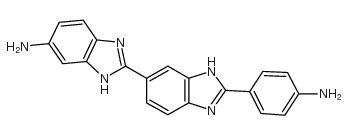Ro 90-7501

Ro 90-7501 structure
|
Common Name | Ro 90-7501 | ||
|---|---|---|---|---|
| CAS Number | 293762-45-5 | Molecular Weight | 340.38100 | |
| Density | 1.443g/cm3 | Boiling Point | 751.035ºC at 760 mmHg | |
| Molecular Formula | C20H16N6 | Melting Point | N/A | |
| MSDS | Chinese USA | Flash Point | 449.122ºC | |
| Symbol |

GHS07 |
Signal Word | Warning | |
Use of Ro 90-7501Ro 90-7501 is an amyloid β42 (Aβ42) fibril assembly inhibitor that reduces Aβ42-induced cytotoxicity (EC50 of 2 μM). Ro 90-7501 inhibits ATM phosphorylation and DNA repair. RO 90-7501 selectively enhances toll-like receptor 3 (TLR3) and RIG-I-like receptor (RLR) ligand-induced IFN-β gene expression and antiviral response[2]. Ro 90-7501 also inhibits protein phosphatase 5 (PP5) in a TPR-dependent manner[3]. Ro 90-7501 has significant radiosensitizing effects on cervical cancer cells[4]. |
| Name | 2-[2-(4-aminophenyl)-3H-benzimidazol-5-yl]-3H-benzimidazol-5-amine |
|---|---|
| Synonym | More Synonyms |
| Description | Ro 90-7501 is an amyloid β42 (Aβ42) fibril assembly inhibitor that reduces Aβ42-induced cytotoxicity (EC50 of 2 μM). Ro 90-7501 inhibits ATM phosphorylation and DNA repair. RO 90-7501 selectively enhances toll-like receptor 3 (TLR3) and RIG-I-like receptor (RLR) ligand-induced IFN-β gene expression and antiviral response[2]. Ro 90-7501 also inhibits protein phosphatase 5 (PP5) in a TPR-dependent manner[3]. Ro 90-7501 has significant radiosensitizing effects on cervical cancer cells[4]. |
|---|---|
| Related Catalog | |
| Target |
Amyloid β42 ATM Protein phosphatase 5 Apoptosis |
| In Vitro | Ro 90-7501 significantly enhances radiosensitivity compared with control HeLa and ME-180 cells. Ro 90-7501 significantly increases apoptosis and impaired cell cycle after irradiation. Ro 90-7501 suppresses the phosphorylation of ATM and its downstream proteins, such as H2AX, Chk1, and Chk2, after irradiation[1]. RO 90-7501, itself affects neither IFN-β nor NFκB promoter activity, but significantly enhances poly I:C-induced IFN-β promoter activation and inhibits the activation of NFκB in a dose-dependent manner. Treatment of cells with RO 90-7501 significantly enhances the antiviral activity of poly I:C[2]. |
| In Vivo | Ro 90-7501 (5 μg/g; intraperitoneal injection; daily; for 21 days; female BALB/c nude mice) treatment significantly delays tumor growth and significantly decreases tumor volume[1]. Animal Model: Female BALB/c nude mice (8-week-old) with HeLa cells under irradiation[1] Dosage: 5 μg/g Administration: Intraperitoneal injection; daily; for 21 days Result: Tumor growth was significantly delayed in the combination group. Tumor volume was also significantly decreased in the irradiation group. |
| References |
| Density | 1.443g/cm3 |
|---|---|
| Boiling Point | 751.035ºC at 760 mmHg |
| Molecular Formula | C20H16N6 |
| Molecular Weight | 340.38100 |
| Flash Point | 449.122ºC |
| Exact Mass | 340.14400 |
| PSA | 109.40000 |
| LogP | 5.10000 |
| Vapour Pressure | 0mmHg at 25°C |
| Index of Refraction | 1.842 |
| Symbol |

GHS07 |
|---|---|
| Signal Word | Warning |
| Hazard Statements | H315-H319-H335 |
| Precautionary Statements | P261-P305 + P351 + P338 |
| Personal Protective Equipment | dust mask type N95 (US);Eyeshields;Gloves |
| Hazard Codes | Xi |
| Risk Phrases | 36/37/38 |
| Safety Phrases | 26-36/37 |
| RIDADR | NONH for all modes of transport |
|
Self-assembly of beta-amyloid 42 is retarded by small molecular ligands at the stage of structural intermediates.
J. Struct. Biol. 130 , 232-246, (2000) Assemblyof the amyloid-beta peptide (Abeta) into fibrils and its deposition in distinct brain areas is considered responsible for the pathogenesis of Alzheimer's disease (AD). Thus, inhibition of fibr... |
|
|
Protein aggregation and neurodegenerative disease.
Nat. Med. 10 Suppl , S10-S17 , (2004) Neurodegenerative diseases such as Alzheimer's disease (AD), Parkinson's disease (PD), Huntington's disease (HD), amyotrophic lateral sclerosis (ALS) and prion diseases are increasingly being realized... |
| Ro 90-7501 |
| 2'-(4-Aminophenyl)-[2,5'-bi-1H-benzimidazol]-5-amine |
| GNF-Pf-5510 |